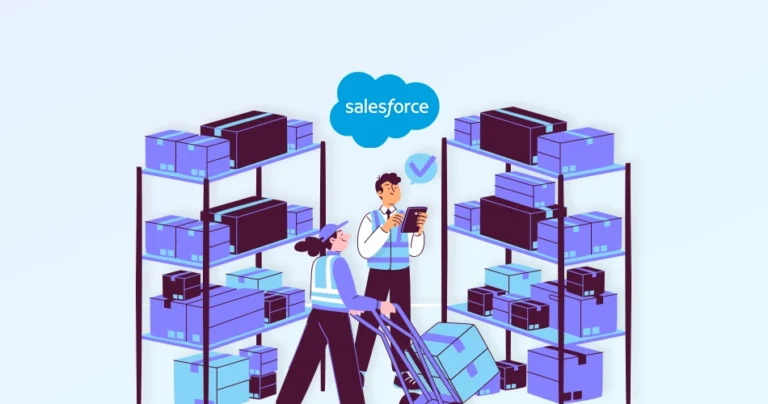A customer places an order online, but delays and miscommunication plague fulfillment. What then? It may lead to frustration and lost revenue. Salesforce order management integration will surely transform the process.
Unifying sales, inventory, and logistics into a seamless system will ensure smooth eCommerce fulfillment. An integrated order management system can centralize data, automate workflows, and provide real-time tracking. It cuts processing times and boosts customer trust.
In this blog, we’ll see how you can integrate order management into your eCommerce website through Salesforce. Without further ado, let’s begin.
What is Order Management?
Order management is the backbone of commerce. It ensures the right product reaches the right customer at the right time. It covers everything from order capture and payment processing to inventory allocation, fulfillment, and post-purchase support.
In multichannel eCommerce, orders come from websites, marketplaces, mobile devices, social media, and in-store transactions. So you need a unified system to avoid risks like overselling stock, shipment delays, or loss of customer requests. That would mean there’s no loss of revenue or reputation.
Key Aspects of Order Management
- Order Capture & Validation: Ensuring orders from websites, marketplaces, or in-store systems are accurately recorded. That includes real-time checks for inventory availability and pricing.
- Inventory Synchronization: Keeping stock levels updated across all sales channels to prevent overselling and stockouts.
- Fulfillment Automation: Routing orders to the best warehouse, supplier, or drop-shipper based on location, cost, and speed.
- Shipping & Tracking: Coordinating carriers, generating labels, and providing customers with real-time delivery updates.
- Returns & Refunds: Managing reverse logistics efficiently to maintain customer satisfaction and restock inventory.
- Reporting & Analytics: Tracking order statuses, fulfillment times, and bottlenecks to optimize operations.
What an eCommerce order management system does is integrate these functions together. It reduces errors, speeds up the delivery, and improves the buyer experience.
Overview of Salesforce Order Management System
Salesforce Order Management is a cloud-based OMS solution. It’s designed to streamline and automate order fulfillment across multiple sales channels. Built natively on the Salesforce platform, it connects commerce, service, and inventory systems into a unified workflow. It eliminates silos and reduces operational friction.
Key Capabilities
- Unified Order Hub: Consolidates orders from eCommerce, marketplaces, call centers, and retail POS into a single view.
- Intelligent Orchestration: Automatically routes orders to optimal fulfillment locations based on inventory, cost, and delivery speed.
- Real-time Inventory Visibility: Syncs stock levels across warehouses, suppliers, and stores to prevent overselling.
- Seamless Service Integration: Links order data with Service Cloud, enabling agents to resolve issues faster.
- AI-powered Insights: Uses Einstein AI to predict delays, recommend fulfillment paths, and optimize workflows.
Salesforce order management is deeply integrated with CRM, marketing, and service tools. It offers a 360-degree view of the customer journey through the website. You can reduce the fulfillment errors and cut down the order processing time. Plus, you can improve customer satisfaction with proactive updates and faster resolutions.
For any business scaling through omnichannel eCommerce, Salesforce OM can ease the order workflows. So hire Ecommerce developers and have the OM set up at the earliest.
Want to integrate advanced Salesforce solutions in your eStore?
How to Integrate Salesforce Order Management?
The Salesforce order management integration streamlines order processing, reduces errors, and enhances customer experiences. Here’s how you go about this process.
Assess Business Requirements
Before integrating Salesforce Order Management, identify your pain points. Here are a few of the points to assess:
- Are orders delayed?
- Is the inventory inaccurate?
- Do customers complain about fulfillment?
Document your current workflow, key challenges, and desired outcomes. So the entire system will align with your business goal, whether it’s faster shipping or seamless omnichannel support.
Set Up Salesforce Order Management
Start by enabling Salesforce OM in your org. Configure basic settings like order types, statuses, and fulfillment rules. Define roles for teams (sales, warehouse, customer service) to ensure smooth collaboration.
This foundational step ensures the system is tailored to your operations before adding complexity.
Connect Data Sources
Your OMS is only as good as its data. Integrate ERP, eCommerce platforms (like Shopify or Magento), and warehouse systems to sync orders, inventory, and customer details in real time. APIs or middleware (like MuleSoft) help bridge gaps between disconnected systems.
Automate Order Routing & Fulfillment
Set rules to auto-route orders based on business logic. Such as shipping from the nearest warehouse, prioritizing express deliveries, or splitting orders across suppliers. Automation reduces manual work, cuts processing time, and minimizes errors.
Integrate with Service Cloud
Link Salesforce OM with Service Cloud so agents see order history, tracking, and fulfillment status during customer interactions. This empowers them to resolve issues faster (like delays or returns) without switching systems, boosting satisfaction.
Test & Optimize
Run test orders to validate workflows—from checkout to delivery. Identify bottlenecks (e.g., payment failures or inventory mismatches) and refine rules. Continuously monitor performance with dashboards and adjust as your business scales.
Want help with getting the best out of Salesforce order management integration? Then get our professional Salesforce development services. But what kind of benefits can you get from the Salesforce OMS?
Benefits of Salesforce Order Management in eCommerce
When we think of an eCommerce website, there are some key integrations to consider, and among the most crucial ones is an order management system. To that end, Salesforce is an excellent solution as it offers a range of benefits.
Unified Order Visibility Across Channels
Thanks to a unified order management solution, you won’t have to juggle between systems anymore. Salesforce OM consolidates orders from your site, app, marketplaces, and in-store POS into a single dashboard. That eliminates overselling and gives you real-time control over inventory and fulfillment.
Faster, Smarter Fulfillment
Automated order routing sends purchases to the optimal fulfillment center based on stock levels, location, and shipping costs. The result? Reduced delivery times and lower operational costs—critical for winning in competitive eCommerce.
Fewer Errors, Higher Customer Satisfaction
OMS can automate manual processes like data entry and inventory updates. It minimizes human errors that lead to wrong shipments, stockouts, or delayed orders. Happy customers mean repeat business and better reviews.
Seamless Returns & Customer Service
You can integrate the order management system with a service cloud. Then your support team can instantly access order details and process returns. Plus, you can resolve issues without switching tabs. Faster resolutions = higher customer retention.
Scalability for Growth
Salesforce OMS lets you expand to new markets, add sales channels, and much more. Its AI-driven analytics also help predict demand, optimize stock levels, and identify trends. That gives a strategic edge.
All in all, this solution can help you ensure flawless eCommerce experiences at scale.
Let’s Summarize
The OMS solution by Salesforce isn’t just about processing orders—it’s about transforming business operations. It unifies sales channels, automates fulfillment, and connects customer service. That eliminates inefficiencies that cost time and revenue.
The result? Faster deliveries, fewer errors, and happier customers. It’s all powered by real-time data and AI-driven insights. This solution can also help you scale into new markets as well as optimize the existing operations.
So, ready to simplify your eCommerce workflow with Salesforce order management? Then connect with us today!
FAQs on Salesforce Order Management
Q1. How does Salesforce differ from a traditional OMS?
Unlike standalone order management systems, Salesforce OM is natively integrated with CRM, Service Cloud, and Einstein AI. This provides real-time customer insights, smarter fulfillment routing, and seamless service interactions.
Q2. Can Einstein AI enhance order management?
Yes. Einstein AI predicts delays, recommends optimal fulfillment paths, and identifies trends to optimize stock levels and reduce costs.
Q3. Can it reduce fulfillment costs with Salesforce OMS?
Yes. By automating workflows, optimizing shipping routes, and minimizing errors, businesses cut operational expenses by up to 30%.
Q4. How does it improve customer service?
Agents get full order visibility in Service Cloud, enabling faster resolutions for returns, tracking, or delays, without switching systems.





